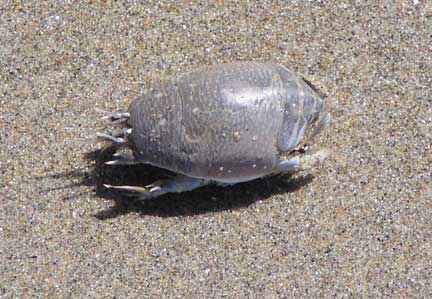|
The mole crab or sand crab, Emerita analoga, is one of the unmistakable characters of our spring and summer beach. We can see both adults and their young. Its egg-shaped body is hydrodynamically sculptured for living in wave-pounded and shifting sands. An anomuran crab of the family Hippidae, mole crabs are gregarious and can b e found in shoals, washing in and out with the surf and the tide, sometimes becoming stranded on the beach. They are called mole crabs, of course, because they burrow, but only in wet sand. They can not dig in sand that is too dry or firmly packed. It has to have enough water to separate the grains and make the sand penatratable. e found in shoals, washing in and out with the surf and the tide, sometimes becoming stranded on the beach. They are called mole crabs, of course, because they burrow, but only in wet sand. They can not dig in sand that is too dry or firmly packed. It has to have enough water to separate the grains and make the sand penatratable.
Mole crabs are herbivores, feeding on dinoflagellates and diatoms, and they feed when the waves recede. Using its legs, a crab will burrow backwards into the sand during an incoming wave. It head is pointed upward facing the surf, its stalked eyes and its small first antennae, which it uses as kind of a snorkel for respiration, projecting from the sand. When a wave goes out, it curls its large, feathery second antennae backward and uses them as nets to capture the phytoplankton. The food is scraped from the antennae by other specialized, brush-like appendages and delivered to the mouth.
Males, smaller than females, are often found higher up on the beach. In fact, larger individuals of both sexes like the deeper surf. A single female can carry more than 20,000 bright orange eggs. The free-swimming zoea larvae are pelagic for three to six months and can be transported long distances by ocean currents. Juveniles may wash  up in dense swarms onto beaches where they burrow just under the sand's surface, giving the beach a lumpy appearance. During May of 2005, the beach between Netarts and Oceanside, to the delight of seagulls, was invaded by massive numbers of juveniles, possibly hundreds of thousands or more per square meter. A small handful of sand would yield hundreds. Each individual was about five millimeters long (right). Very few juveniles reach adulthood. Most, when washed back out to sea, become food for other animals. Adults are also food for a variety of shorebirds, and they are a favorite food of surfperch. When I was a kid, I used mole crabs as bait when fishing for surfperch. up in dense swarms onto beaches where they burrow just under the sand's surface, giving the beach a lumpy appearance. During May of 2005, the beach between Netarts and Oceanside, to the delight of seagulls, was invaded by massive numbers of juveniles, possibly hundreds of thousands or more per square meter. A small handful of sand would yield hundreds. Each individual was about five millimeters long (right). Very few juveniles reach adulthood. Most, when washed back out to sea, become food for other animals. Adults are also food for a variety of shorebirds, and they are a favorite food of surfperch. When I was a kid, I used mole crabs as bait when fishing for surfperch.
Text and photographs by Jim Young
Oceanside, Oregon
jsy4990@embarqmail.com
|

